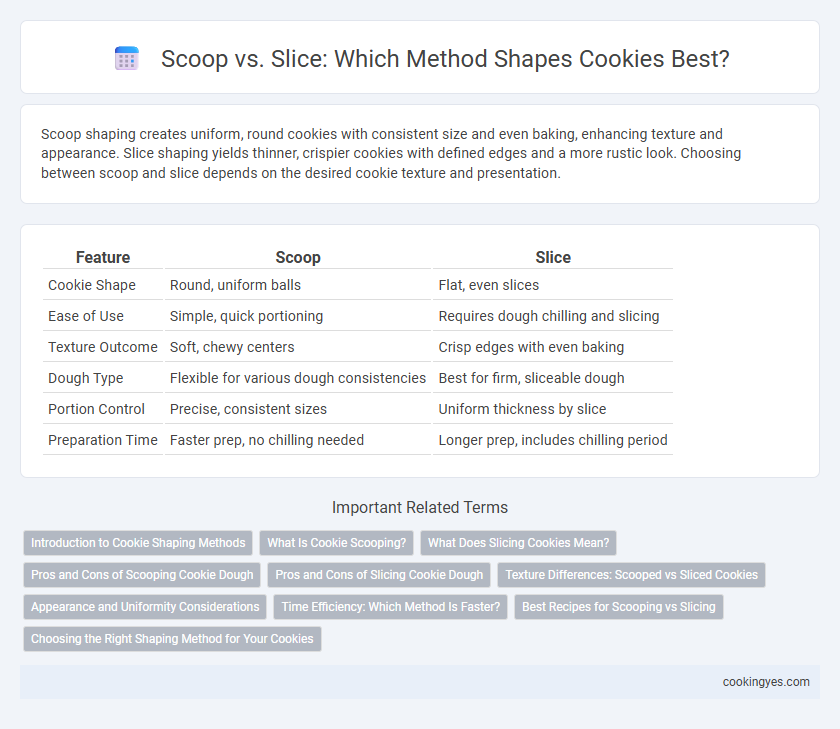Scoop shaping creates uniform, round cookies with consistent size and even baking, enhancing texture and appearance. Slice shaping yields thinner, crispier cookies with defined edges and a more rustic look. Choosing between scoop and slice depends on the desired cookie texture and presentation.
Table of Comparison
| Feature | Scoop | Slice |
|---|---|---|
| Cookie Shape | Round, uniform balls | Flat, even slices |
| Ease of Use | Simple, quick portioning | Requires dough chilling and slicing |
| Texture Outcome | Soft, chewy centers | Crisp edges with even baking |
| Dough Type | Flexible for various dough consistencies | Best for firm, sliceable dough |
| Portion Control | Precise, consistent sizes | Uniform thickness by slice |
| Preparation Time | Faster prep, no chilling needed | Longer prep, includes chilling period |
Introduction to Cookie Shaping Methods
Scoop and slice are two popular cookie shaping methods that significantly influence the final texture and appearance of cookies. Scooping ensures consistent cookie size and uniform baking by using a cookie scoop or spoon to portion dough into rounded balls. Slicing involves forming dough into a log, chilling it, and then cutting into even slices, which creates uniform thickness and crisp cookie edges for a different texture experience.
What Is Cookie Scooping?
Cookie scooping involves using a cookie scoop, a small, rounded utensil that evenly portions cookie dough for uniform size and shape, ensuring consistent baking and appearance. Scoops come in various sizes, typically measured in teaspoons or tablespoons, allowing precise control over dough quantity and preventing irregularities common in slicing methods. This technique streamlines the cookie-making process and results in evenly baked cookies with professional presentation.
What Does Slicing Cookies Mean?
Slicing cookies refers to shaping cookie dough into a log or block, chilling it, and then cutting it into individual rounds before baking. This method ensures uniform cookie sizes and consistent baking times, resulting in evenly cooked, perfectly round cookies. Slicing is ideal for doughs that hold shape well, like shortbread or butter cookies, offering a precise and efficient approach to cookie preparation.
Pros and Cons of Scooping Cookie Dough
Scooping cookie dough ensures uniform cookie size, promoting even baking and consistent texture throughout the batch. This method reduces spreading issues and helps maintain the desired cookie shape, making it ideal for drop cookies. However, scooping can be time-consuming and may require additional cleaning of the scoop between uses to prevent dough buildup.
Pros and Cons of Slicing Cookie Dough
Slicing cookie dough offers precise thickness control, ensuring uniform baking and consistent texture throughout the batch. It reduces dough handling, which minimizes spreading and maintains cookie shape better than scooping. However, slicing requires firm dough and can be less flexible for portion size adjustment, potentially limiting variety in cookie shapes.
Texture Differences: Scooped vs Sliced Cookies
Scooped cookies typically have a thicker, chewier texture due to their rounded shape retaining more moisture during baking. Sliced cookies, cut from a chilled dough log, often produce a denser, crisper bite with uniform thickness that promotes even baking. Texture differences arise as scooping encourages a soft interior and slight crisp edges, while slicing yields a firmer and more consistent crunch.
Appearance and Uniformity Considerations
Using a scoop for cookie shaping ensures uniform size and consistent, rounded appearance, which promotes even baking and professional presentation. Slicing cookie dough often results in varied thickness and irregular shapes, potentially causing uneven baking and less polished aesthetics. Consistency in cookie size achieved by scooping supports uniform texture and enhances overall visual appeal.
Time Efficiency: Which Method Is Faster?
Using a cookie scoop significantly reduces shaping time by quickly portioning uniform dough balls, ideal for batch baking. Slicing dough requires chilling and precise cutting, which adds steps and increases preparation time. For speed and consistency, scooping offers a more time-efficient cookie shaping method.
Best Recipes for Scooping vs Slicing
Using a cookie scoop ensures uniform dough portions that bake evenly, ideal for drop cookies like chocolate chip and oatmeal raisin. Slicing cookie dough, as seen in recipes like shortbread and sugar cookies, creates uniform thickness and clean edges, perfect for decorative or sturdy cookies. Scoop-shaped cookies tend to be softer and thicker, while slice-shaped cookies offer a crisp, consistent texture.
Choosing the Right Shaping Method for Your Cookies
Using a scoop for cookie shaping ensures consistent portion sizes and uniform baking, especially for drop cookies like chocolate chip or oatmeal. Slicing dough from a rolled log is ideal for slice-and-bake cookies, providing precise thickness and easy shaping for varieties such as shortbread or pinwheel cookies. Selecting the right method depends on the cookie type and desired texture, with scooping favoring soft, rounded cookies and slicing producing firm, evenly shaped treats.
Scoop vs Slice for Cookie Shaping Infographic

 cookingyes.com
cookingyes.com